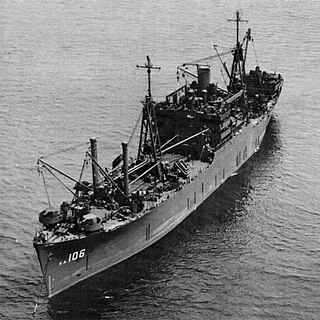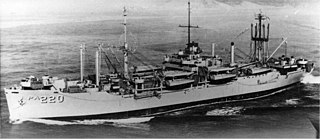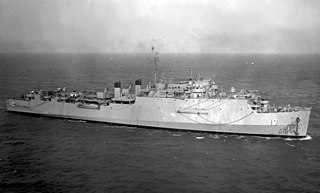
USS Tarawa (LHA-1), the lead ship of her class, is an amphibious assault ship that served in the United States Navy from 1976 to 2009. She is the second ship to be named for the Battle of Tarawa, fought during World War II. Tarawa was decommissioned on 31 March 2009, at San Diego Naval Base.

USS Anchorage (LSD-36) was the lead ship of the Anchorage-class dock landing ship of the United States Navy. In the ship's 34 years of service, she completed 19 deployments in the western Pacific and became the most decorated dock landing ship on the west coast.

USS Tortuga (LSD-26) was a Casa Grande-class dock landing ship in the United States Navy. She was the first Navy ship to be named for the Dry Tortugas, a group of desert coral islets 60 miles west of Key West, Florida, which were discovered in 1513 by Spanish explorer Ponce de Leon.

USS Paul Revere (APA/LPA-248) was the lead ship of the Paul Revere class of attack transport in the United States Navy. She was named for the early patriot and Founding Father, Paul Revere (1735–1818). She later served in the Spanish Navy as Castilla (L-21).

USS Alamo (LSD-33) was a Thomaston-class dock landing ship of the United States Navy. She was named for the Alamo, site of the 1836 Battle of the Alamo.

USS Union (AKA-106) was a Tolland-class attack cargo ship of the United States Navy, the fourth ship with this name, and served as a commissioned ship for 25 years and 1 month.

USS Ashland (LSD-1) was the lead ship of her class—the first dock landing ship of the United States Navy. She was the first Navy ship to be named for Ashland, the estate of Henry Clay, in Lexington, Kentucky.

USS Gunston Hall (LSD-5) was an Ashland-class dock landing ship in the United States Navy, named in honor of Gunston Hall, the estate of George Mason (1725–1792), one of the Founding Fathers of the United States. Originally designated APM-5, Gunston Hall was launched 1 May 1943 by the Moore Dry Dock Company, Oakland, California, sponsored by Mrs. Harvey S. Haislip; and commissioned 10 November 1943.

USS Epping Forest (LSD-4/MCS-7) was an Ashland-class dock landing ship acquired by the U.S. Navy during World War II for duty in the Pacific Theater. Her task was to carry and land amphibious landing craft and other equipment and to recover and repair landing craft when possible. Named for an estate in Lancaster County, Virginia where Mary Ball Washington, mother of George Washington, was born, she was the only U.S. Naval vessel to bear the name.

USS Henrico (APA-45) was a Bayfield-class attack transport that served with the United States Navy in World War II, and subsequently in the Korean War, Cold War and Vietnam War.

USS Okanogan (APA/LPA-220) was a Haskell-class attack transport that saw service with the US Navy in World War II, the Korean War and the Vietnam War. She was of the VC2-S-AP5 Victory ship design type and named after Okanogan County, Washington.

USS Vernon County (LST-1161) was a United States Navy, Terrebonne Parish-class tank landing ship in commission from 1953 to 1973. She saw extensive service in the Vietnam War before being transferred to the Venezuelan Navy, where she became Amazonas (T-21).

USS Belle Grove (LSD-2) was an Ashland-class dock landing ship of the United States Navy, named in honor of Belle Grove Plantation, the birthplace of President James Madison (1751–1836) in Port Conway, Virginia.

USS Oak Hill (LSD-7) was an Ashland-class dock landing ship of the United States Navy, named in honor of Oak Hill, the Virginia estate of President James Monroe (1758–1831).

USS Casa Grande (LSD-13) was a Casa Grande-class dock landing ship of the United States Navy, named in honor of Casa Grande Ruins National Monument near Coolidge, Arizona.

USS Catamount (LSD-17) was a Casa Grande-class dock landing ship of the United States Navy, named in honor of the Catamount Tavern in Old Bennington, which served as headquarters for Ethan Allen's Green Mountain Boys while making their plans against the New Yorkers and the British. The Catamount was also the meeting place of Vermont's only form of government then: the Vermont Council of Safety.

USS Colonial (LSD-18) was a Casa Grande-class dock landing ship of the United States Navy, named in honor of the Colonial National Historical Park, which comprises Jamestown, Williamsburg, and Yorktown in southeastern Virginia.

USS Comstock (LSD-19) was a Casa Grande-class dock landing ship of the United States Navy. She was the first navy ship named in honor of the Comstock Lode in Nevada, discovered in 1859, which was one of the richest deposits of precious metals known in the world.

USS Fort Marion (LSD-22) was a Casa Grande-class dock landing ship of the United States Navy. She was named for the Castillo de San Marcos in St. Augustine, Florida, which was named Fort Marion from 1821 till 1942.

USS Whetstone (LSD-27) was a Casa Grande-class dock landing ship of the United States Navy. She was named in honor of Whetstone Point, at end of peninsula between the old Basin of downtown Baltimore. The peninsula which also later contained the residential communities of South Baltimore, Federal Hill and Locust Point is bordered by the |Northwest Branch and the Middle and Ferry Branches on the Patapsco River, which is also Baltimore Harbor. Location of Revolutionary War fortifications of Fort Whetstone from the 1770s and the previous site of later Fort McHenry reconstructed beginning in 1798 was named for James McHenry, third Secretary of War under Presidents George Washington and John Adams. The star-shaped fort which defended Baltimore, Maryland from British assault with a two-day bombardment in 12–14 September 1814, during the War of 1812. The poem "Defence of Fort McHenry" when set to music inspired the national anthem, "The Star-Spangled Banner" written as a poem by Francis Scott Key from an off-shore truce ship downriver.




















